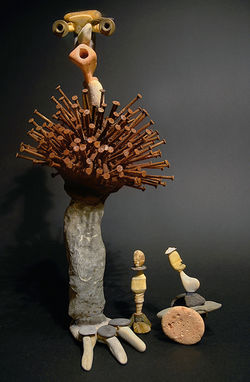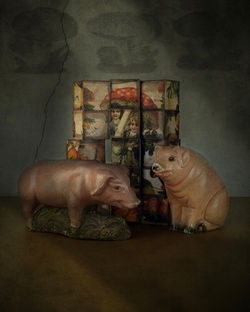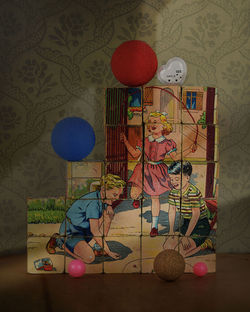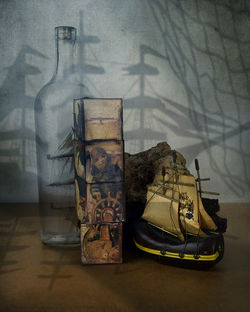
Echoes of Play:
Oriol Vaz & Emanuelle Becker
September 25 – October 14, 2025, Barcelona
 |  |
|---|---|
 |  |
 |  |
 |  |
 |  |
 |  |
 |  |
 |  |
 |  |
 |  |
Click on the thumbnail to view the image. Click on the image for a larger view and information.
Please scroll down to see the photographs and artist statement by Emmanuelle Becker, as well as the opening remarks by Robert Morrissey.
Artist statement
Oriol Vaz: Toys Series
These pages are dedicated to the memory of the Spanish artisan Benjamín Martino Martino (1935-2010), in order to reveal the creative process of my sculptures made out of iron and stones. We intend to inquire how far the poetic experience can be constructed in a distinctive way of knowledge, bringing together some unpublished sketches, pictures and writings from several travel books. For this purpose we have tried to give an order to the creative stages leading to both the confection of the public sculpture Auriga (2004) and the current series of Sibyls, consisting of fifty “toys” assembled with small stones from Etruscan lands. Linking the artist’s intuition with the humanist’s analytical language, we will explore the bounds between Art, Play and Myth, the three main components of the works here treated. In this research, the wonder is also presented as the pristine mechanism of the creative impulse of the artist, the child and mythopoiesis —present in the archaic cultures’ meta-narratives—. Therefore, the sense of wonder does not lead to the suspension of human mind but to a strong motion of the imagination. This last is the child’s natural condition that the adult poet must fight to regain, considering perchance in wonder remains hidden what Stefan Zweig describes as “the secret of artistic creation.”
Source: Vaz-Romero Trueba, Oriol. 2015. “Auriga y mis juguetes de piedra: Una aventura escultórica entre arte y juego. In memoriam Benjamín Martino.” Barcelona Research, Art, Creation 3, no. 3 (October): 277–308.
https://doi.org/10.17583/brac.2015.1562
Biography
European Doctor in Learning Sciences at the Sorbonne University (Paris-13) and in Fine Arts at the University of Barcelona (UB). For his pictorial and set design works, made between 2002 and 2006, he has received the Extraordinary Degree Award (2007).
He is Painting Professor at the Faculty of Fine Arts of the UB and he teaches «The History of Graphic Illustration» at EINA, Centre for Design and Art attached to the Universitat Autònoma de Barcelona.
As a passionate explorer of the border between art and play, in 2007 he undertook his ambitious study on the history and semiotics of toys and playthings thanks to a Research Grant of the Generalitat de Catalunya (2007-2010).
From 2008 he has been part of the EXPERICE Laboratory (Universités Paris-8 and Paris-13), specialized in childhood’s material culture, under the direction of Gilles Brougère and Michel Manson. From those years of study in Paris, his doctoral thesis The Artist and the Toy: trips to the western imaginaries, from Antiquity to the Romanticism (2011), distinguished with the Extraordinary Doctorate Award (2012) and the Doctors’ Senate Award of the UB (2014).
To find out more about Oriol Vaz, click here:
Website: https://oriolvaz.com/
Emmanuelle Becker: Child’s Play
 |  |
|---|---|
 |  |
 |  |
 |  |
 |  |
 |  |
 |  |
 |  |
 |  |
 |  |
 |  |
 |  |
 |
Click on the thumbnail to view the image. Click on the image for a larger view and information.
Artist statement
Emmanuelle Becker: Child’s Play
"Child's Play" is a photographic portfolio of quirky still lifes in which I arrange time-worn trinkets and toys to have them interact in the dark narratives I create. In these photographs, I am interested in addressing and representing the many complex emotions and desires that drive humans, such as sexuality, ambition, conflict, jealousy, fear, and hope. I see the objects like characters in a play. I am interested in their emotional life. Like in the theater, I try to create dramatic tension in my photography. My images do not tell stories per se, but offer the viewer visual ingredients, snippets of context that suggest narratives.
I like to explore flea markets. I do not go with a specific idea in my mind but rather let the knick-knacks I run across speak to me. It is, in fact, the object itself that suggests a character, an emotion or an idea, as if its raison d'être had always been to take life in the scenes that I imagine. While browsing the stands, I combine my acquisitions in my head into different scenarios.
I have always been interested in Surrealist thought and art. I mention this here because the Surrealists believed in the occult life of objects and their power to engage our feelings and thoughts.
Back at the studio, I build my compositions like children play. I move objects around and bring them to life through the characters they interpret in the scene and what their role symbolizes. Like children, I try to reproduce the world around me. I hope that the final image will evoke memories of significant experiences that have somehow shaped our understanding of the world, indeed who we have become, individually and collectively. My photographs can be comical or kitschy, and sometimes provocative. Vintage wallpapers, candy-colored highlights, dreamy moods, and looming shadows contribute to the subtext of each image. The nostalgic quality which characterizes this series, underlines the importance of memory in perception.
Perception is a mix of subconscious sensory stimulation combined with cognitive activity. This continuous and simultaneous brain activity triggers a slew of physical sensations that we recognize as emotions and organize into structured thought.
I am interested in exploring the more emotional side of perception in my photography. The cognitive mechanisms involved in processing information rely on learned notions which influence and orient our understanding of the world. So much of perception is subsequently filtered, inhibiting us from truly seeing.
The scale of the objects, the directional lighting and the centered and frontal compositions are visual devices that help establish an intimacy with the viewer to lead her/him to introspection and reflection.
Biography
Emmanuelle Becker is a Franco-American artist-photographer living in Paris. She studied photography and printmaking at George Washington University in Washington, DC., graduating with honors, and pursued a master's degree in painting at Pratt Institute in NYC. She has exhibited her work in Europe, Western Asia, and the United States and is the recipient of multiple awards and distinctions. Her work has been featured in several international photography publications.
Opening Remarks by Robert Morrissey
Echoes of Play
Let’s begin with the question- what is play, both in childhood and adulthood?
Donald Winnicott, the British pediatrician and psychoanalyst, described play as a “potential space”—not just fantasy, not just cold reality, but in some uniquely human in-between space.
We’ve all witnessed it in children, absorbed in their invented worlds. Winnicott saw this not as a trivial childhood phase, but as a developmental achievement—a territory where the self gets to be curious, creative and alive.
However, this “potential space of play” isn’t just for children, though it often does not survive into adulthood. Our adult inner world becomes filled with mundane tasks, duties, obligations and expectations. Play often becomes regarded as a childish and irrelevant activity and quietly dries up.
At its heart, play is about curiosity, testing out the new-we try on new selves. We create new stories. However, play is fragile and fraught with minefields. For children and adults, the ability to play depends on safety: the sense that we can risk a little, be a bit weird and/or transgressive, even fail, without being punished or shamed.
You get to fail and try again, and in the process, you get to practice frustration tolerance, foster problem-solving skills, and you create something new. Play is that rare paradox where you are both safe and exploring, known and changing, vulnerable and protected. [1]
In the work of Oriol Vaz, the material culture of childhood (games and toys, illustrated books, children's rooms and furniture) informs his theory and practice. He enlists areas of inquiry as diverse as the philosophy of art, the study of ancient religions, sociology, and contemporary art criticism.
Vaz defines the toy as "the best symbolic container for our experiences of wonder, as natural in the life of a child as they are latent in the creations of adults of all time."
* * *
In the work of Emmanuelle Becker, trinkets, dolls and toys found at flea markets, are staged to interact in the dark narratives she presents. She writes, “I am interested in addressing and representing the many complex emotions and desires that drive humans, such as sexuality, ambition, conflict, jealousy, fear, and hope.”
She cites the influence of the theater as well as an abiding interest in Surrealist thought and art.
She adds, “the Surrealists believed in the occult life of objects and their power to engage our feelings and thoughts.”
Becker’s work might also be viewed through the lens of “The Uncanny Valley,” a term coined by Japanese robotics professor Masahiro Mori. In The Uncanny Valley, dolls and puppets walk a fine line between the living and inanimate, their pseudo-human presence can evoke both attraction and unease, which artists can use to generate a subtle dialogue between what is real and not real.[2]
Becker states that, “Like children, I try to reproduce the world around me. I hope that the final image will evoke memories of significant experiences that have somehow shaped our understanding of the world, indeed who we have become, individually and collectively.
"Anybody who has survived his childhood has enough information about life to last him the rest of his days." [3]
- Flannery O'Connor
References
[1] Winnicott, Donald W. (2017). Caldwell, Lesley; Helen Taylor Robinson (eds.). The Collected Works of D. W. Winnicott, Volume 5, 1955–1959. Oxford University Press.
[2] Mori, M. (2012). "The Uncanny Valley [From the Field]". IEEE Robotics & Automation Magazine. 19 (2). Translated by MacDorman, K. F.; Kageki, Norri. New York City.
[3] O'Connor, Flannery (1979). Fitzgerald, Sally (ed.). The Habit of Being: Letters of Flannery O’Connor. Farrar, Strauss and Giroux. New York City.

